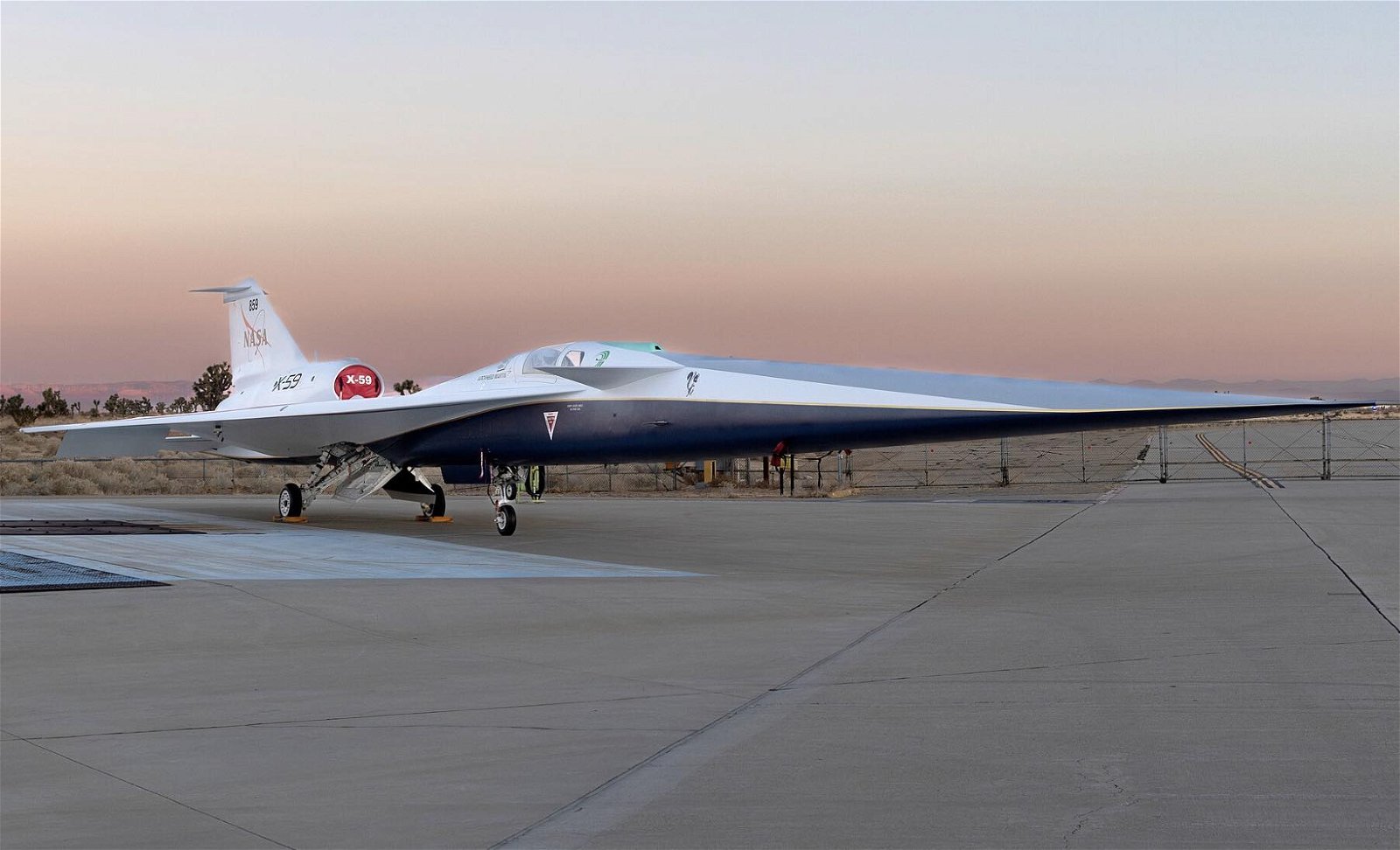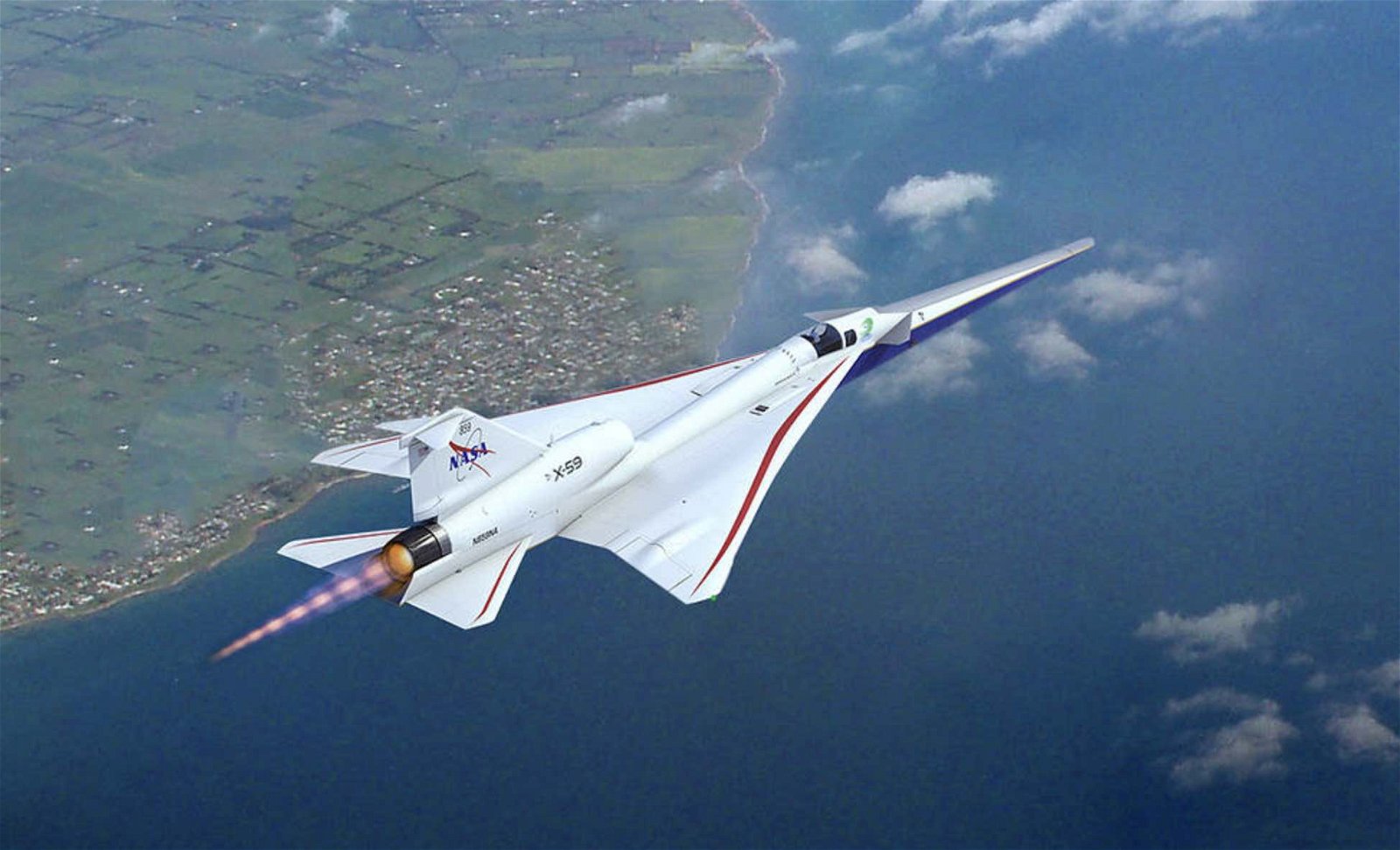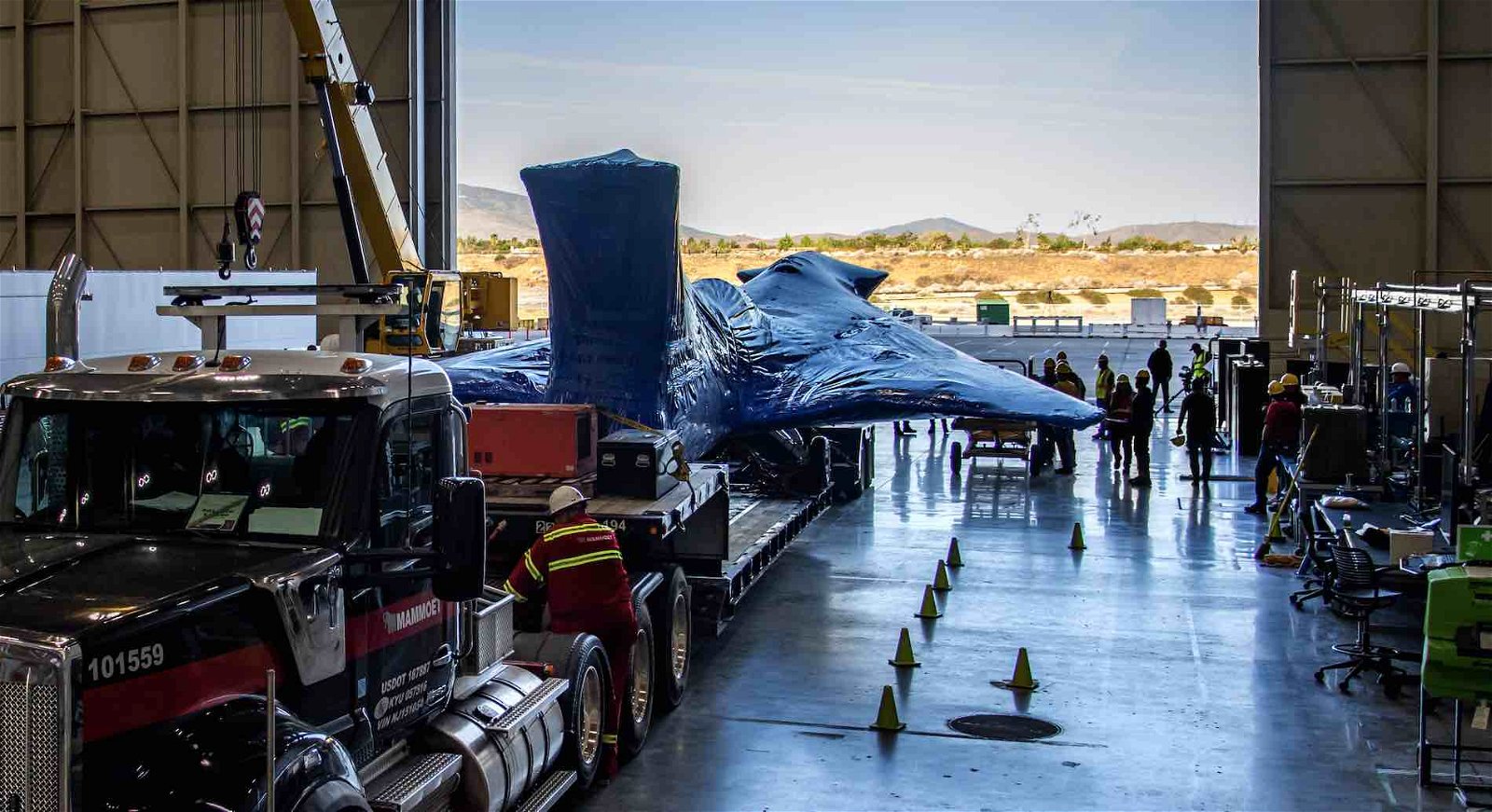

Welcome to this week’s Intelligence Brief… on Wednesday, NASA announced that its mission to deliver quiet supersonic flight to commercial aviation saw significant advancements as its experimental X-59 moves toward verification of airworthiness. We’ll be taking a look at 1) the latest developments with the supersonic aircraft as it moves toward its testing phase, 2) how NASA’s Quesst mission aims to revitalize the long-dormant commercial component of overland supersonic flight, and 3) what will be required as the X-59 undergoes some of its most significant assessments yet.
Quote of the Week
“None of these systems have ever worked and played together before. It’s a brand-new thing that we are developing, even though they’re components that have been on different legacy aircraft.”
– Brad Neal, X-59 Airworthiness and Flight Safety Review board chairman
Latest News: Recently at The Debrief, a warp drive breakthrough has been unveiled by leading propulsion researchers, DARPA is funding the development of a military-grade quantum laser prototype, and experts theorize that AI superintelligence could be the reason we haven’t detected alien civilizations. All of our recent stories can be found at the end of this week’s newsletter.
Podcasts: In podcasts this week, on The Debrief Weekly Report, Kenna and Stephanie examine new insights unearthed from ancient lava tubes in Saudi Arabia. Over on The Micah Hanks Program, I take a look at the folklore surrounding Utah’s controversial Skinwalker Ranch, as well as recent developments related to research efforts conducted at the alleged UFO hotspot. You can subscribe to all The Debrief’s podcasts on our Podcasts Page.
Video News: On the latest episode of Rebelliously Curious, Chrissy Newton is joined by Neel Lee Chauhan, Founder of MNDLB5 (Mind Labs) and former Music Music DJ turned tech entrepreneur who discusses the ethical dilemmas, creative potentials and future possibilities of AI in music. Be sure to check out other great content from The Debrief on our official YouTube Channel.
Now, it’s time to examine NASA’s efforts to bring quiet supersonic flight to commercial aviation as its groundbreaking experimental aircraft approaches one of its most crucial challenges yet.
NASA’s X-59 Moves Closer to Taking Flight
This week, NASA reported the completion of a milestone review that will enable its supersonic X-59 “quiet” aircraft to move toward flight.
The Lockheed Martin X-59 Quesst, produced by the aerospace giant’s famous Skunk Works, is an experimental aircraft built for NASA’s Low-Boom Flight Demonstrator project. The aircraft, which NASA hopes will revolutionize air travel by reintroducing commercial airplanes capable of exceeding the speed of sound, was officially unveiled earlier this year.


On Wednesday, the American space agency announced that a Flight Readiness Review board had finished studying the X-59 project team’s safety protocols for staff and the public before ground and flight tests, marking the first phase in the aircraft’s flight approval process.
NASA’s Quesst Mission
The X-59 is the flagship of NASA’s Quesst mission, which aims to produce supersonic aircraft with a quieter “thump.”
At just under 100 feet in length and around 30 feet in width, the X-59 represents the future of 21st-century quiet supersonic aircraft design. Nearly a third of the aircraft’s overall length comprises its elongated nose, a key design feature that allows the X-59 to disrupt the shock waves that typically cause sonic booms that occur during supersonic flight. Existing regulations prohibiting overland supersonic flight stem from flights of the Supersonic Transport Concorde close to half a century ago.


At the X-59’s official unveiling in January, Bob Pearce, associate administrator for aeronautics research at NASA Headquarters, said NASA plans to “share the data and technology we generate from this one-of-a-kind mission with regulators and with industry,” and will “seek to open new commercial markets for U.S. companies and benefit travelers around the world.”
Airworthiness of America’s “Quiet” Supersonic Aircraft
During its recent Flight Readiness Review, the X-59 team’s work underwent assessment and review, during which the team presented a progress update in advance of the Airworthiness and Flight Safety Review, which will involve senior leaders from both NASA and the X-59’s builders at Lockheed Martin.
During this stage of evaluation, the NASA and Lockheed Martin reviewers will examine the X-59 team’s current findings and responses, which will serve as crucial factors in receipt of the aircraft’s airworthiness certificate. Lastly, a technical brief on the various experimental objectives, methods, risks, and mitigation plans will also be presented.


Prior to flight, the X-59 team will also be required to address any issues that arise during the evaluation period prior to the signing of its official flight request. Currently, several tasks remain to be completed, and the X-59 team is preparing for ground tests that will also mark an important phase in the aircraft’s testing and evaluation, where engine performance will be assessed, as well as any potential for electromagnetic interference.
“It’s really an exciting time on the project,” said Cathy Bahm, NASA’s Low Boom Flight Demonstrator project manager, in a statement this week.
“It’s not an easy road, but there’s a finite set of activities that are in front of us.”
That concludes this week’s installment of The Intelligence Brief. You can read past editions of The Intelligence Brief at our website, or if you found this installment online, don’t forget to subscribe and get future email editions from us here. Also, if you have a tip or other information you’d like to send along directly to me, you can email me at micah [@] thedebrief [dot] org, or Tweet at me @MicahHanks.


Here are the top stories we’re covering right now…
- Warp Drive Breakthrough Could Enable Constant-Velocity Subluminal Travel, Physics Team Says
A warp drive breakthrough has been unveiled by leading propulsion researchers in in a groundbreaking new study.
- Parabolic Flight Experiments Test Boiling in Partial Gravity to Prepare Future Off-World Colonists
Southwest Research Institute scientists are studying boiling in partial gravity to help future off-world colonists survive in space.
- Archaeologists Unearth New Clues That Could Help Solve Centuries-Old “Lost Colony” Mystery
New evidence uncovered by archaeologists is bringing researchers closer than ever to revealing the fate of the famous Lost Colony of Roanoke.
- DARPA Funding Military-Grade Quantum Laser Prototype
DARPA is funding the development of a military-grade quantum laser prototype that can penetrate dense fog and operate over long distances.
- Artificial Superintelligence Could Doom Humanity and Explain We Haven’t Found Alien Civilizations, Proposes New Research
A recent study suggests artificial superintelligence could be the reason we haven’t detected alien civilizations, warning of AI’s existential risks to humanity.
- Researchers Studying Proxima Centauri b Tout ‘Significant Leap Forward’ in Understanding Habitable Earth-Like Planets
A new analysis of exoplanet Proxima Centauri b marks a significant leap forward in understanding habitable Earth-like planets.
- Earthquake Swarms with No Clear Trigger Have Baffled Scientists for Years. This May Be What’s Causing Them.
New research has revealed that earthquake swarms may be linked to climate events that include heavy snowfall and rain, according to new findings by MIT scientists and an international team of colleagues.
- James Webb Space Telescope Data Reveals New Insights Into the Brightest Gamma Ray Burst Ever Detected
James Webb Space Telescope data is offering new clues about a massive supernova associated with the brightest gamma-ray burst ever recorded.
- Star Wars Tatooine-Style Planet with Two Suns Found Orbiting in the Habitable Zone
A Tatooine-style planet with two suns like Luke Skywalker’s home in ‘Star Wars’ has been spotted in its host star’s habitable zone.
- Most Severe Geomagnetic Storm Forecast in Two Decades Could Mean Northern Lights Sightings
A severe geomagnetic storm is expected to occur over the weekend, which space weather experts say will likely begin as early as Friday afternoon or evening.
- Future Humans Could be Haunted by Digital “Ghosts” of Their Dead Loved Ones, Researchers Warn
Researchers warn that people could become unintended targets of emotional distress from AI “deadbots” that emulate their deceased loved ones.
- 1600-Year-Old Stone Inscribed in Mysterious Ancient Language Unearthed in Accidental Discovery
A peculiar stone inscribed with a mysterious ancient language is revealing new insights to the ancient history of the British Isles.
- UK Space Agency Testing Extremely Low Orbit Propulsion System That Runs on Solar Power and Thin Air
UK’s new extremely low orbit propulsion system that could keep satellites aloft for years at a time will run on solar power and thin air
- Generative AI for Top Secret Missions? Microsoft Deploys GPT-4 for Classified Operations
Welcome to this week’s Intelligence Brief… on Tuesday, it was announced that Microsoft is deploying its GPT-4 large language model for use with its cloud services for classified work. In our analysis, we’ll be examining 1) the tech giant’s recent announcement, 2) a quick look at the history of Microsoft’s Azure Government Top Secret, and 3) the steps forward in the U.S. government’s implementation of GPT-4 for work in classified operations. Quote of the Week “We are going to have […]
- The UFO Silencers
This week, we look at AARO’s investigations into potentials means by which those with insider knowledge could be potentially be held accountable, and finally, the UFO folklore involving claims of “UFO silencers” from over the decades.
- A Neanderthal Skull Puzzle?
On today’s episode, Kenna and Stephanie stare into the eyes of an ancient Neanderthal, explore who she was, and how scientists were able to reconstruct her face.
- UAPs in Canada: A Conversation with MP Larry Maguire on Disclosure, Transparency, and Government Action
In a conversation with The Debrief, Canadian MP Larry Maguire shares his thoughts on the UAP subject and the Canadian government’s position on these phenomena.
- James Webb Space Telescope Finds ‘Best Evidence to Date’ for Rocky Exoplanet Atmosphere
NASA researchers using the James Webb Space Telescope have detected the ‘best evidence to date’ for a rocky exoplanet atmosphere.
- New “Iontronic Memristor” Could Revolutionize Brain-Like Computing Using Only Salt and Water
The iontronic memristor, a breakthrough device mimicking human brain synapses with salt and water is advancing neuromorphic computing.
- Stanford Researchers Create First-Ever Augmented Reality 3D Holographic Headset Using Ordinary Glasses
A team of Stanford researchers has created the world’s first augmented reality 3D holographic headset using ordinary glasses.
- Deep Within These Ancient Lava Tube Caves, Archaeologists Have Made an Unprecedented Discovery
Archaeologists say remarkable archaeological discoveries are being unearthed deep within ancient lava tube caves in northern Saudi Arabia.
- These Enigmatic “Yooperlites” Found in Michigan Reveal a Luminous Surprise Under Ultraviolet Light
In Michigan’s Upper Peninsula, stones called “Yooperlites” that glow when exposed to ultraviolet (UV) light are capturing the fascination of the rockhounding world.
